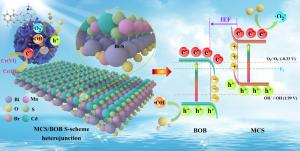A chemically bonded photocatalyst with rich oxygen vacancies for improved photocatalytic decontamination
USA, April 8, 2024 /EINPresswire.com/ -- Devising novel heterojunction photocatalysts applied in annihilating pharmaceuticals and chromium contamination is significant for addressing the problem of global water pollution and it's quite challenging to devise a facile approach to modulate the interfacial chemical bonds of the heterojunction. The paper offers a solvothermal method to synthesize a chemically bonded Mn0.5Cd0.5S/BiOBr S-scheme heterostructure with oxygen vacancies (OVs) for high-efficiency destruction of tetracycline hydrochloride and Cr(VI).
A challenge in promoting the industrial application of photocatalysis technology for environment remediation lies in the design of high-performance photocatalysts. These photocatalysts should be endowed with efficient photo-carrier separation and intense redox potentials to boost photocatalytic pollutant removal.
In a study (doi:10.1016/j.apmate.2024.100183) published in the KeAi journal Advanced Powder Materials, a group of researchers from Zhejiang Ocean University and University of Missouri revealed the modulation of interfacial chemical bond of Mn0.5Cd0.5S/BiOBr assisted by with rich oxygen vacancies. This in turn elucidated the underlying mechanism for boosted photocatalytic performance.
"BiOBr is a visible-light active photocatalyst with several advantages, including a favorable band configuration, exceptional photo-oxidative capacity, distinctive 2D architecture, ecological compatibility, abundant resources and robust durability," explained Shijie Li, co-lead author of the study. "However, constrained absorption of visible light and sluggish photo-carrier diffusion and segregation hamper its practical application.”
The team developed an S-scheme photosystem of Mn0.5Cd0.5S/BiOBr with interfacial bond and oxygen defects, constructed by pinning Mn0.5Cd0.5S nanoparticles on BOB microflowers. This was devised for efficacious decontamination of antibiotic and Cr(VI).
“Physical contact without chemically bonding hetero-interface between the two components, which is insufficiently interactive, generally results in an unsatisfactory charge migration passage” added Bin Zhang, co-lead and co-corresponding author. “Besides, defect engineering is another effective strategy to upgrade the catalytic property. Thus, precise construction of chemically bonded S-scheme heterojunction with structural defects is essential for efficient photocatalytic water purification, but is rarely exploited in photocatalytic applications.”
The team’s findings provide a feasible approach to develop outstanding catalysts for environmental protection via combining interfacial chemical bonds and defects modulated S-scheme junction.
DOI
10.1016/j.apmate.2024.100183
Original Source URL
https://doi.org/10.1016/j.apmate.2024.100183
Funding information
This work was supported by the National Natural Science Foundation of China (U1809214), the Natural Science Foundation of Zhejiang Province (LY20E080014 and LTGN23E080001), and the Science and Technology Project of Zhoushan (2022C41011).
Lucy Wang
BioDesign Research
email us here
Legal Disclaimer:
EIN Presswire provides this news content "as is" without warranty of any kind. We do not accept any responsibility or liability for the accuracy, content, images, videos, licenses, completeness, legality, or reliability of the information contained in this article. If you have any complaints or copyright issues related to this article, kindly contact the author above.

